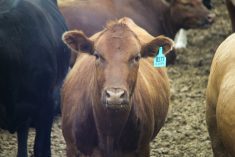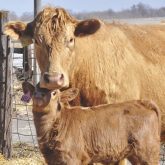With better nutrition and management and a higher incidence of twins in the Charolais, Simmental, and Holstein breeds, some larger herds can have up to a 10 per cent twinning rate.
With the odds of 50 per cent of the twins being mixed sexes, it is no wonder freemartins are not an uncommon occurrence. Remember though that being twins of mixed sexes is not a guarantee the female will have no or undeveloped reproductive organs. In eight per cent of cases, a normal intact heifer is the result, which if kept could reproduce normally.
Read Also

Dennis Laycraft to be inducted into the Canadian Agricultural Hall of Fame
Dennis Laycraft, Executive Vice President of the Canadian Cattle Association, is one of this year’s inductees into the Canadian Agricultural Hall of Fame. Laycraft was nominated for his many contributions to the cattle industry.
Freemartins become a bit of a management headache for several reasons. They are often the ones orphaned onto another cow and their identity as a twin may be lost. Because of their masculine characteristics, they grow very well and most often end up in the upper 25 percentile for growth — and so inadvertently will be kept as replacements. If in the feedlot and identified, they should be given a steer implant as their hormonal profile more closely mimics a steer. The issue here is they tend to get ridden lots if put in the steer pen and are the more aggressive ones if put in the heifer pen. Sometimes they end up in the chronic pen and stay there until finished.
Veterinarians can pick out these freemartin heifers if you have them palpated to select for breeding soundness next spring. Several beneficial things are accomplished at palpating. As mentioned, the freemartin heifers are identified and removed as well as any pregnant ones (teenage pregnancies), ones with abnormally small pelvises, or those which are reproductively underdeveloped. One must remember any twin intact heifers genetically have more of a predisposition to twin themselves. If you want a higher incidence of twins in your herd, select them as replacements and if not, cull them. The choice is yours.
If you don’t palpate heifers before selection, the management issue is keeping track of these freemartin heifers. The first is identifying them for sure. There are several ways to do this. Most have abnormally developed external genitalia with a very prominent protruding clitoris and what I describe as feathery vulval lips. There is a small instrument which measures the depth of the vaginal vault or a person can use a plastic test tube. Measure some normal heifers to get the average depth. Freemartin heifers will be considerably shorter to the point of having no vaginal vault. This measurement is made within a few days of birth. Then identify these freemartins with a distinct tag or notch their existing tag. The bottom line is making them distinguishable down the production line. Blood or DNA tests can also be done for freemartin determination and is useful if their external genitalia looks normal and they are potentially valuable breeding stock.
The huge loss that comes with freemartins is when they are kept, and kept, and kept not having a calf and remaining in the herd. I have personally palpated several four- to five-year-old freemartins with the producer wondering why they have not calved. If you purchase heifer replacements, again keep in mind some may be freemartins. When palpating in the heifer shows pen of 10- or pen of five-type competitions, it is not uncommon to find some freemartins present. They are selected because, as already mentioned, they have superior growth.
A good rule when selecting heifers is always remove the top five per cent of your heifers for growth as they may have higher levels of male hormones and similar to freemartins will have poor fertility or be totally sterile.
If you see dairy heifers for sale, do an about face as they most likely are freemartins (as most intact dairy heifers are kept as replacements with the high culling rate in the dairy industry). It would be nice to have a standardization of tagging across the industry for freemartins, but that will probably never come to pass.
I have looked at some triplets and the same principal applies — most are freemartins if there is a bull calf in the mix. Other bovines such as bison have had freemartins documented even though twinning is less common than cattle. Most bison bottle-fed babies are likely twins and they should be checked before keeping them as replacements.
We also rarely see hermaphrodites (intersexes) in the cattle industry and these should be put in the same category. They are sterile and should be fed out as slaughter animals. But the beef in all these animals is of high quality and has no bearing on taste or tenderness. If a bull calf survives in a set of twins to 60 days gestation and then is resorbed, then the surviving heifer calf’s reproductive organs have already been affected and it may be born a freemartin.
In the purebred industry you may want to have freemartins checked out because, as mentioned, about eight per cent will have a complete uterus and will breed. This is one other criterion to consider when selecting your replacement heifers. At the same time your other heifers can be palpated for small pelvises, unwanted pregnancies, scarring, or internal abscesses.
This will hopefully eliminate problems down the line and increase the longevity of your heifers when they calve or are sold as breeding replacements.















